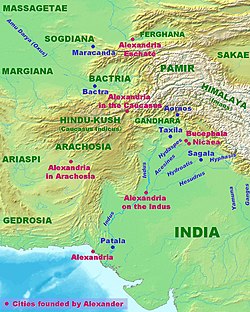
Alexander III of Macedon, most commonly known as Alexander the Great, was a king of the ancient Greek kingdom of Macedonia. He succeeded his father Philip II to the throne in 336 BC at the age of 20 and spent most of his ruling years conducting a lengthy military campaign throughout Western Asia, Central Asia, parts of South Asia, and Egypt. By the age of 30, he had created one of the largest empires in history, stretching from Greece to northwestern India. He was undefeated in battle and is widely considered to be one of history's greatest and most successful military commanders.
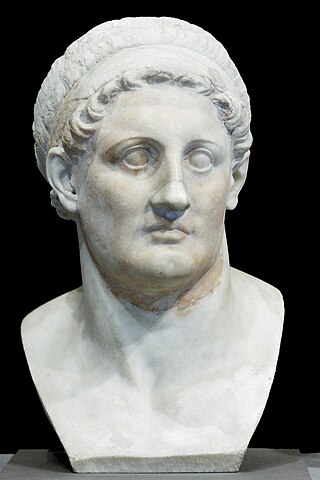
Ptolemy I Soter was a Macedonian Greek general, historian, and successor of Alexander the Great who went on to found the Ptolemaic Kingdom centered on Egypt. Ptolemy was basileus and pharaoh of Ptolemaic Egypt from 305/304 BC to his death in 282 BC, and his descendants continued to rule Egypt until 30 BC. During their rule, Egypt became a thriving bastion of Hellenistic civilization and Alexandria a great seat of Greek culture.
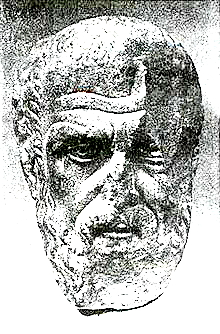
Arrian of Nicomedia was a Greek historian, public servant, military commander, and philosopher of the Roman period.

Nearchus or Nearchos was one of the Greek officers, a navarch, in the army of Alexander the Great. He is known for his celebrated expeditionary voyage starting from the Indus River, through the Persian Gulf and ending at the mouth of the Tigris River following the Indian campaign of Alexander the Great, in 326–324 BC.

Bucephalus or Bucephalas, was the horse of Alexander the Great, and one of the most famous horses of classical antiquity. According to the Alexander Romance (1.15), the name "Bucephalus" literally means "ox-headed", and supposedly comes from a brand on the thigh of the horse that looked like an ox's head.

The wars of Alexander the Great were a series of conquests carried out by Alexander III of Macedon from 336 to 323 BC. They began with battles against the Achaemenid Empire, then under the rule of Darius III. After Alexander's chain of victories, he began a campaign against local chieftains and warlords that stretched from Greece to as far as the region of Punjab in South Asia. By the time he died, Alexander ruled over most regions of Greece and the conquered Achaemenid Empire, including much of Achaemenid Egypt; he did not, however, manage to conquer the Indian subcontinent in its entirety according to his initial plan.

The Anabasis of Alexander was composed by Arrian of Nicomedia in the second century AD, most probably during the reign of Hadrian. The Anabasis is a history of the campaigns of Alexander the Great, specifically his conquest of the Persian Empire between 336 and 323 BC. Both the unusual title "Anabasis" and the work's seven-book structure reflect Arrian's emulation of the Greek historian Xenophon, whose own Anabasis in seven books concerned the earlier campaign "up-country" of Cyrus the Younger in 401 BC.
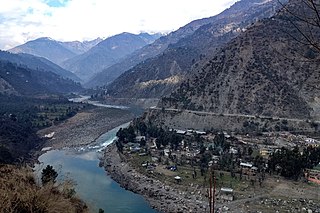
The Chenab River is a major river that flows in India and Pakistan, and is one of the 5 major rivers of the Punjab region. It is formed by the union of two headwaters, Chandra and Bhaga, which rise in the upper Himalayas in the Lahaul region of Himachal Pradesh, India. The Chenab flows through the Jammu region of Jammu and Kashmir, India, into the plains of Punjab, Pakistan, before ultimately flowing into the Indus River. The Battle of Chenab was fought between Sikhs and Afghans on the bank of the river.

Philip, son of Machatas and brother of Harpalus, was an officer in the service of Alexander the Great, who in 327 BC was appointed by Alexander as satrap of India, including the provinces westward of the Hydaspes, as far south as the junction of the Indus with the Acesines. After the conquest of the Malli (Malwa) and Oxydracae, these tribes also were added to his government.
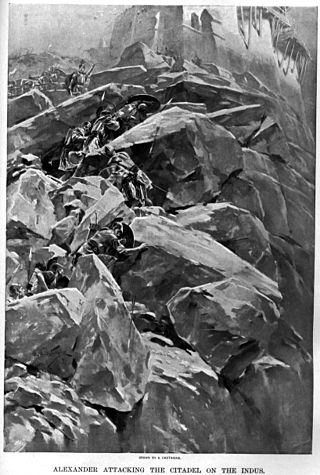
Aornos was the site of Alexander the Great's last siege, which took place in April 326 BC, at a mountain site located in modern Pakistan. Aornos offered the last threat to Alexander's supply line, which stretched, dangerously vulnerable, over the Hindu Kush back to Balkh, though Arrian credits Alexander's desire to outdo his kinsman Heracles, who allegedly had proved unable to take a fort that the Macedonians called Aornos : meaning "birdless" in Greek. According to one theory, the name is a corruption of an Indo-Iranian word, such as *awarana "fortified place". According to Arrian, the rock had a flat summit well-supplied with natural springs and wide enough to grow crops: it could not be starved into submission. Neighboring tribesmen who surrendered to Alexander offered to lead him to the best point of access.
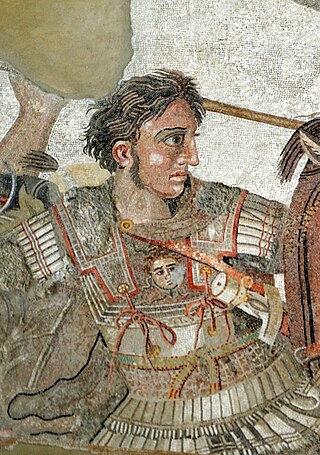
Indica is the name of a short military history about interior Asia, particularly India, written by Arrian in the 2nd century CE. The subject of the book is the expedition of Alexander the Great that occurred between 336 and 323 BCE, about 450 years before Arrian. The book mainly tells the story of Alexander's officer Nearchus' voyage from India to the Persian Gulf after Alexander the Great's conquest of the Indus Valley. However, much of the importance of the work comes from Arrian's in-depth asides describing the history, geography, and culture of Ancient India. Arrian wrote his Indica in the Ionic dialect, taking Herodotus for his literary mode.

Pushkalavati, was the capital of the ancient region of Gāndhāra, situated in present day's Pakistan. Its ruins are located on the outskirts of the modern city of Charsadda, in Charsadda District, in the Khyber Pakhtunkhwa, 35-42 kilometres northeast of Peshawar, at the banks of Jindi River, near the junction of Swat River with Kabul River. The earliest archaeological remains in Bala Hisar mound are from 1400 to 800 BCE. Pushkalavati may have been incorporated as an Achaemenid regional settlement around 520 BCE, and it remained an important city through to the beginning of 3rd century CE.
Peithon, son of Agenor (Αγήνωρ) was an officer in the expedition of Alexander the Great to India, who became satrap of the Indus from 325 to 316 BC, and then satrap of Babylon, from 316 to 312 BC, until he died at the Battle of Gaza in 312 BC.
Boukephala and Nikaia (Νίκαια) were two cities founded by Alexander the Great on either side of the Hydaspes during his invasion of the Indian subcontinent. The cities, two of many founded by Alexander, were built shortly after his victory over the Indian king Porus at the Battle of the Hydaspes in early 326 BC.

The Indian campaign of Alexander the Great began in 327 BC and lasted until 325 BC. After conquering the Achaemenid Persian Empire, the Macedonian army undertook an expedition into the northwestern Indian subcontinent. Within two years, Alexander expanded the Macedonian Empire to include Gandhara and the Indus Valley, surpassing the earlier frontiers that had been established by the Persian conquest of the Indus Valley.

The Cophen campaign was conducted by Alexander the Great in the Kabul Valley between May 327 BC and March 326 BC. It was conducted against the Aspasioi, the Guraeans, and the Assakenoi tribes in the Kunar valley of Afghanistan, and Panjkora (Dir) and Swat valleys in what is now Khyber Pakhtunkhwa, Pakistan. The goal of the campaign was to secure the Macedonian line of communications so that the Macedonian army could proceed into India proper.
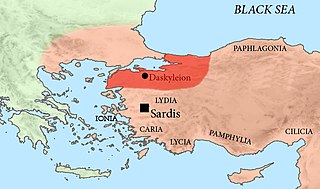
Arsites was Persian satrap of Hellespontine Phrygia in the Achaemenid Empire in the 4th century BC. His satrapy also included the region of Paphlagonia.
Oreitans/Oritans and Oreitians/Oritians were the ancient inhabitants of modern Lasbela District in Balochistan province of Pakistan.

Nagara, also known as Dionysopolis (Διονυσόπολις), was an ancient city in the northwest part of India intra Gangem, distinguished in Ptolemy by the title ἡ καὶ Διονυσόπολις 'also Dionysopolis'. It also appears in sources as Nagarahara, and was situated between the Kabul River and the Indus, in present-day Afghanistan. The site of Nagara is usually associated with a large stupa called Nagara Ghundi, about 4 kilometres (2.5 mi) west of Jalalabad near Tepe Khwaja Lahori, south of the junction of the Surkhäb and Kabul rivers, where ancient ruins have been found.
Hermaion or Hermaeum (Latin) was a location in ancient Mysia, which formed part of the border between the city-states of Lampsacus and Parium. It was probably the same place as Hermoton, mentioned by Arrian, and may have been the site of a village or town. It was located near Çınardere, Turkey.
